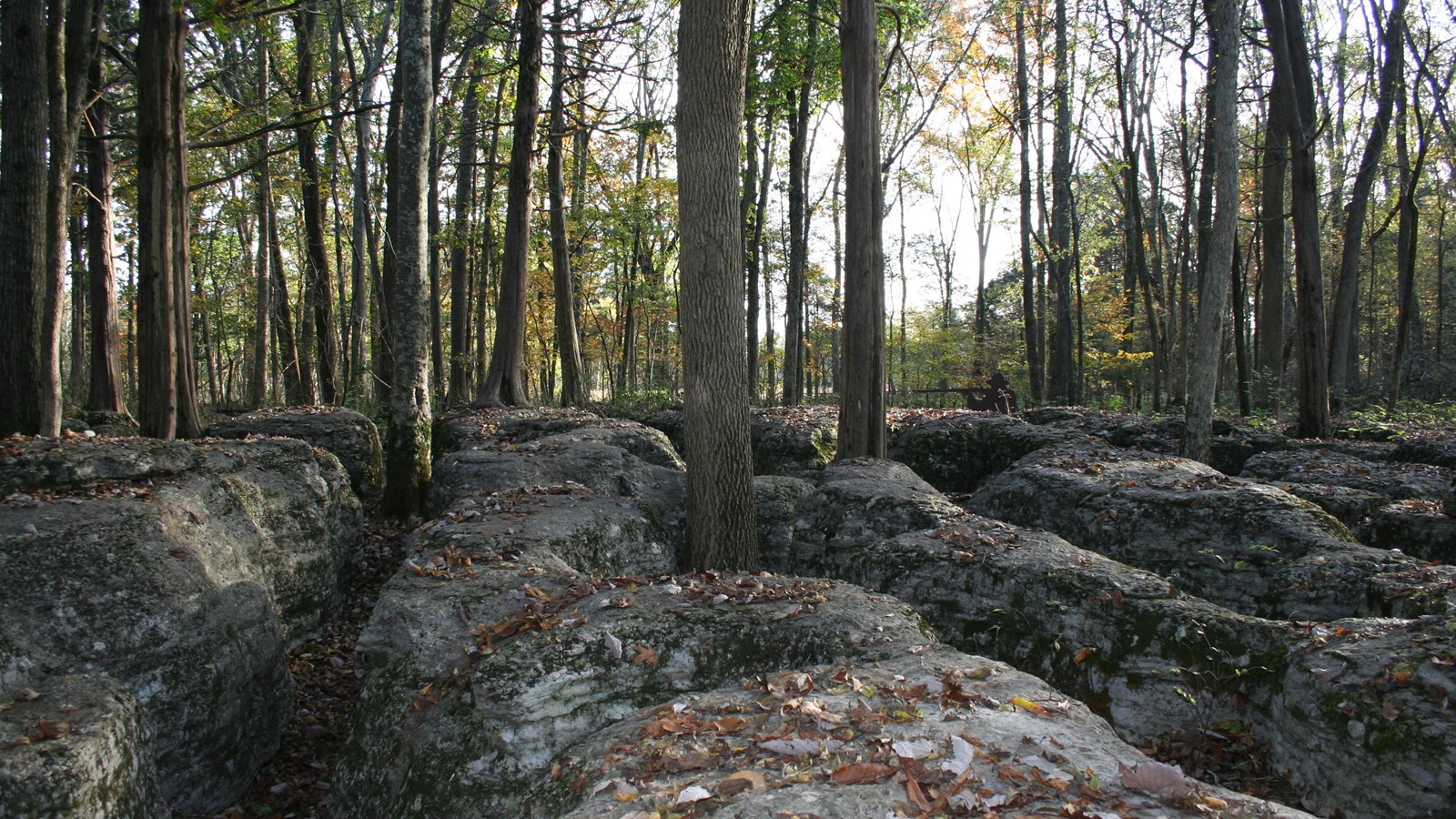Last updated: July 23, 2022
Place
Auto Tour Stop 2 - The Slaughter Pen

NPS Photo
Audio Description, Cellular Signal, Historical/Interpretive Information/Exhibits, Parking - Auto, Parking - Bus/RV, Scenic View/Photo Spot
The Battle of Stones River began at 6 AM on December 31, 1862. The Confederate divisions of Generals McCown and Cleburne smashed into the right flank of the Union lines near the intersection of Gresham Lane and the Franklin Pike. The Union right crumbled and were soon sent flying north and west in disarray.
Further down the Union line, Gen. Philip Sheridan had his men up and ready to fight by 4 AM. As the Confederates descended upon their position, they stopped and beat back attacks to their front. However, they soon had to contend with the threats to their right and rear as the Union line continued to fall back. Sheridan's division bent backwards as they struggled to keep the enemy in front of them. In the process, two of Sheridan's brigade commanders, Gen. Joshua Sill and Col. George Roberts, were killed. Some of Sheridan's regiments lost more than half their men before they moved north of the Wilkinson Pike to the cover of the dense cedar forest.While Sheridan's division slowly bent back to the Wilkinson Pike, Gen. James Negley's men stood their ground. They beat back several Confederate attacks from the east.
Private J.E. Robuck of the 29th Mississippi Infantry described the fighting here:
"Our regiment was on a large field in which corn had grown, but the stalks had been cut. The Yankees had planted a battery in the cedar grove across the field, and the... regiments were ordered to charge and take the battery. When we started across the field I thought those were the deepest middles between corn rows that I had ever seen... They were among the trees, while were in an open field, so they were just mowing us down like weeds. We were ordered to fall down … to escape their bullets, shells and cannon balls. I changed my opinion about the middles – they appeared to be entirely too shallow."
By 10 AM, the Confederates had pushed Sheridan and Negley into a "V' formation. Sheridan's lines faced south, while Negley's division still fired to the east. This dangerous position risked seeing both divisions cut off from the rest of the army as the Confederates attacked from all sides.
Yet, they had no choice! Orders had arrived from Gen. Rosecrans informing both generals that they must hold to buy time for the rest of their army to regroup along the Nashville Pike.
Upon receiving their orders to stand fast, Gen. Negley's men sought safety among the limestone outcroppings and trees behind them. It worked for a time. The Union forces here stalled nearly half the Confederate army for two hours. At noon, Sheridan's lines finally broke. This allowed Confederate soldiers to begin to surround Negley's men from the rear. The boys in blue found their rocky shelter had now become a death trap.
Learn more about the fighting in the Slaughter Pen by watching this video from our friends at the American Battlefield Trust.
Transcript
On the morning of December 31, 1862, General William J. Hardee sent 10,000 men from McCown's and Cleburne's divisions, storming through and around the unprepared Union right flank. The men of Richard Johnson's division were so terrified they immediately retreated. As more men began to retreat, it created even more fear and chaos throughout the Union right wing.
The Confederate line began to wrap around the Union line, breaking up Johnson's division and then rolling around the positions of General Jefferson C. Davis's division. When the fight came to General Philip Sheridan and his men, they stopped the advance because they were ready to fight by 4:00 AM. Sheridan bent back his lines grudgingly as the Rebels began to push them all the way back to this spot, north of the Wilkinson Pike. Sheridan's lines and those of General James Negley formed a v-shaped salient here.
General William S. Rosecrans, realizing his initial attack plan was failing, began to change his focus from defending the vital Nashville Pike. And he began to reform the line. But he needed time to be able to do so. So he sent word to Generals Sheridan and Negley to hold their positions here to give him that time. These woods and limestone outcroppings provided shelter and protection to those worn out soldiers of Sheridan's and Negley's brigades.
For two hours, General Sheridan and General Negley held their position, fighting off attacks from three different sides. Eventually, Sheridan's men, exhausted from fighting for several hours and low on ammunition, retreat leaving Negley and his men nearly surrounded. While this area was a great source of cover, it quickly turned into a death trap as the men tried to retreat through the rocks and trees.
There was so much blood that when the soldiers of Chicago saw the area after the fighting, they nicknamed it the "Slaughter Pen", as it reminded them of the slaughter houses back home. While the terrible losses they suffered by Sheridan and Negley's men here surely had them thinking that all hope was lost, the seeds of ultimate Union victory were sown by their sacrifices. Five Union brigades had stalled nearly half of the Confederate Army for two hours. This gave Rosecrans the time he needed to set his troops for a final decisive stand along the Nashville Pike.
- Duration:
- 2 minutes, 36 seconds
Student Conservation Association intern Emily Brandon tells the story of the bloody delaying action that turned the tide of battle.
